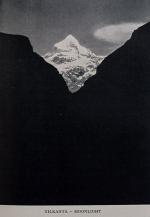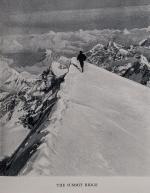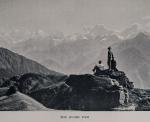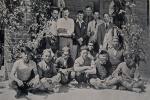Smythe, Kamet Conquered.
Kamet Conquered.
First edition. London, Victor Gollancz Ltd, 1932. 15 cm x 23.5 cm Frontispiece, XVI, 420 pages. 59 additional illustrations. Fold-out trace map at rear showing route of 1920 Kamet Expedition. Hardcover [publisher’s original dark cloth] with gilt lettering on spine. Very good condition with only minor signs of external wear. Rubbing to board edges at top and bottom. Some light foxing to title- and halftitle pages and very occasional hints of foxing to an otherwise bright and clean interior.
Includes, for example, the following: The Himalaya / To Ranikhet / The Kuari Pass / The Base Camp / Kamet Conquered / To Gamsali / The Bhyunder Pass and the Valley of Flowers / The Arwa Valley / Sources of the Gnages / Some Medical Aspects of High Climbing, by Raymond Greene / The Flowers of the Kamet and Badrinath Ranges, by R.L. Holdsworth / Appendices – IV. Weather – V. Food – VI. Equipment – VII. Photography and Cinematography etc.
This book tells of Smythe’s successful bid to make the first ascent of Kamet (7,756 metres) in 1931, which was then the highest altitude that had reached by climbers. He did so without the aid of supplementary oxygen!
Sir Francis Younghusband provides a preface which makes mountaineering sound akin to combat or warfare:
″The struggle of man with the mountains continues apace. Man reels back again and again. But again and again her returns to the onslaught. What is it in the mountains that so allures him? … What is the secret of it? Quite certainly it is the power the mountain has to force the best out of man. Man likes to be at his best. But often nothing short of a Himalayan peak can extract it from him – can compel him to be his fittest in body, alertest in mind, and firmest in soul. So he is drawn to the mountain. And the mountain makes a man of him. And he is grateful. This is the true secret of the lure of the mountain.” (p.xv)
Smythe, a vastly experienced mountaineer, has a deep respect for the Himalayas: “The Himalaya must be approached humbly. Respect their beauty, their majesty, and their power, and they will treat you as you deserve. approach them ignorantly or in a spirit of bravado, and they will destroy you. Other mountains forgive mistakes, but not the Himalayas.” (p.8)
Smythe, having completed a successful expedition to the summit, tells the reader about what he has learned from the mission to Kamet: expedition membership and choosing personnel are discussed; the necessary physical attributes needed for climbers in the Himalaya. At the end of the book Smythe offers further advice concerning mountaineering equipment and supplies.
Francis Sydney Smythe, better known as Frank Smythe or F. S. Smythe (1900-1949), was an English mountaineer, author, photographer and botanist. He is best remembered for his mountaineering in the Alps as well as in the Himalayas, where he identified a region that he named the “Valley of Flowers”, now a protected park. His ascents include two new routes on the Brenva Face of Mont Blanc, Kamet, and attempts on Kangchenjunga and Mount Everest in the 1930s. Smythe died of cerebral malaria at the start of an expedition to the Himalaya in 1949.
- Keywords: Avalanche · Botany · British Mountaineering · British Sports · climbing · Expedition · Expeditions · Ganges River · Himalaya · Himalayas · Kamet Expedition · Library & Collection Building · Medical · Mountaineer’s Mountain · Mountaineering · Mountaineering – Collection · Mountaineering – Rare · Mountaineers · Mountains · Nature · Nature Photography · Pilgrimage · Religion · Travel · Travel & Expedition – Rare · Travel and Adventure · Travel Guide · Travel Writing · Travellers · Travelling Authors
- Language: English
- Inventory Number: 120109AB
© 2025 Inanna Rare Books Ltd. | Powered by HESCOM-Software














